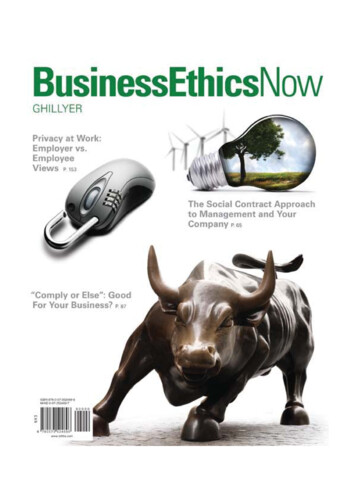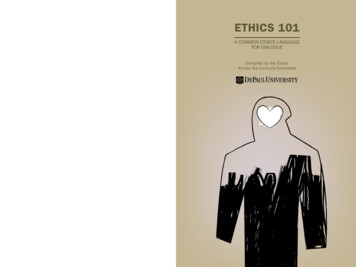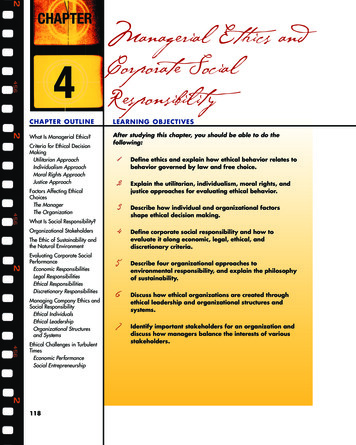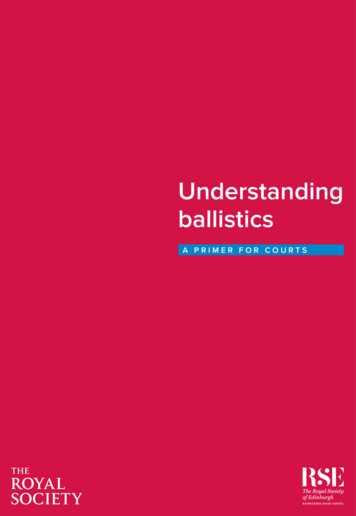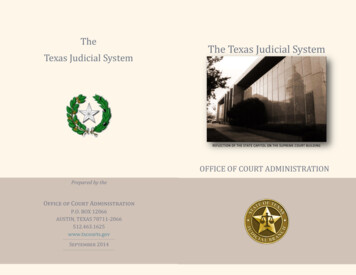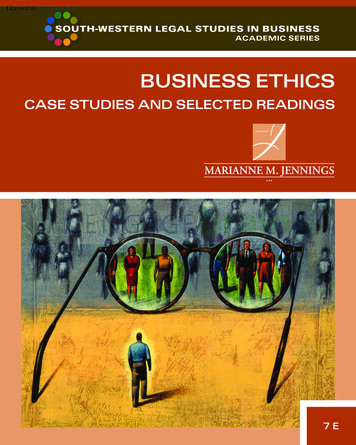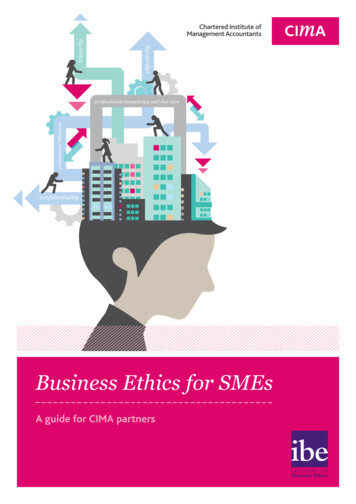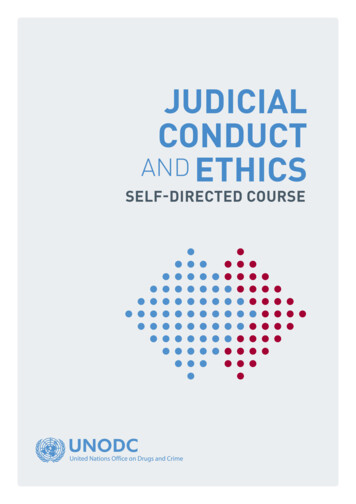
Transcription
JUDICIALCONDUCTAND ETHICSSELF-DIRECTED COURSE
UNITED NATIONS OFFICE ON DRUGS AND CRIMEViennaJUDICIALCONDUCTAND ETHICSSELF-DIRECTED COURSEUNITED NATIONSVienna, 2019
United Nations, March 2019. All rights reserved.The designations employed and the presentation of material in this publication do not imply theexpression of any opinion whatsoever on the part of the Secretariat of the United Nations concerning the legal status of any country, territory, city or area, or of its authorities, or concerning thedelimitation of its frontiers or boundaries.This publication has not been formally edited.Publishing production: English, Publishing and Library Section, United Nations Office at Vienna.
JUDICIAL CONDUCT AND ETHICS—SELF-DIRECTED COURSE CONTENTSAcknowledgements . . . . . . . . . . . . . . . . . . . . . . . . . . . . . . . . . . . . . . . . . . . . . . . . . . . . . . . . . viiIntroduction. . . . . . . . . . . . . . . . . . . . . . . . . . . . . . . . . . . . . . . . . . . . . . . . . . . . . . . . . . . . . . . . . 1Learning outcomes. . . . . . . . . . . . . . . . . . . . . . . . . . . . . . . . . . . . . . . . . . . . . . . . . . . . . . . . . . . 2Short entry test . . . . . . . . . . . . . . . . . . . . . . . . . . . . . . . . . . . . . . . . . . . . . . . . . . . . . . . . . . . . . . 3Core documents. . . . . . . . . . . . . . . . . . . . . . . . . . . . . . . . . . . . . . . . . . . . . . . . . . . . . . . . . . . . . . 4Bangalore Principles of Judicial Conduct. . . . . . . . . . . . . . . . . . . . . . . . . . . . . . . . . . . . . . . . . 5History. . . . . . . . . . . . . . . . . . . . . . . . . . . . . . . . . . . . . . . . . . . . . . . . . . . . . . . . . . . . . . . . . 5Link to the United Nations Convention against Corruption. . . . . . . . . . . . . . . . . . . . . . . 6How do the Bangalore Principles correspond with judicial oaths? . . . . . . . . . . . . . . . . 7Exercise 1 . . . . . . . . . . . . . . . . . . . . . . . . . . . . . . . . . . . . . . . . . . . . . . . . . . . . . . . . . . . . . . 7PRINCIPLE 1.JUDICIAL INDEPENDENCE . . . . . . . . . . . . . . . . . . . . . . . . . . . . . . . 9Individual and institutional independence. . . . . . . . . . . . . . . . . . . . . . . . . . . . . . . . . . . . . . . . 10Link between judicial conduct and independence . . . . . . . . . . . . . . . . . . . . . . . . . . . . . . . . . 10Separation of powers . . . . . . . . . . . . . . . . . . . . . . . . . . . . . . . . . . . . . . . . . . . . . . . . . . . . . . . . 11Exercise 2 . . . . . . . . . . . . . . . . . . . . . . . . . . . . . . . . . . . . . . . . . . . . . . . . . . . . . . . . . . . . . 11Bangalore Principle 1.1. . . . . . . . . . . . . . . . . . . . . . . . . . . . . . . . . . . . . . . . . . . . . . . . . . . . . . . 12Case study: Ms. White . . . . . . . . . . . . . . . . . . . . . . . . . . . . . . . . . . . . . . . . . . . . . . . . . . . 13Case study: The Philanthropic Club . . . . . . . . . . . . . . . . . . . . . . . . . . . . . . . . . . . . . . . . 14Bangalore Principle 1.2. . . . . . . . . . . . . . . . . . . . . . . . . . . . . . . . . . . . . . . . . . . . . . . . . . . . . . . 15Exercise 3 . . . . . . . . . . . . . . . . . . . . . . . . . . . . . . . . . . . . . . . . . . . . . . . . . . . . . . . . . . . . . 15Exercise 4 . . . . . . . . . . . . . . . . . . . . . . . . . . . . . . . . . . . . . . . . . . . . . . . . . . . . . . . . . . . . . 16Social media and digital security. . . . . . . . . . . . . . . . . . . . . . . . . . . . . . . . . . . . . . . . . . . . . . . 17Social media game. . . . . . . . . . . . . . . . . . . . . . . . . . . . . . . . . . . . . . . . . . . . . . . . . . . . . . 17Top tips. . . . . . . . . . . . . . . . . . . . . . . . . . . . . . . . . . . . . . . . . . . . . . . . . . . . . . . . . . . . . . . . 18Examples. . . . . . . . . . . . . . . . . . . . . . . . . . . . . . . . . . . . . . . . . . . . . . . . . . . . . . . . . . . . . . 19Exercise 5 . . . . . . . . . . . . . . . . . . . . . . . . . . . . . . . . . . . . . . . . . . . . . . . . . . . . . . . . . . . . . 21Example: Facebook. . . . . . . . . . . . . . . . . . . . . . . . . . . . . . . . . . . . . . . . . . . . . . . . . . . . . . 21Case study: Judge Sheen. . . . . . . . . . . . . . . . . . . . . . . . . . . . . . . . . . . . . . . . . . . . . . . . . 22iii
JUDICIAL CONDUCT AND ETHICS—SELF-DIRECTED COURSEBangalore Principle 1.3. . . . . . . . . . . . . . . . . . . . . . . . . . . . . . . . . . . . . . . . . . . . . . . . . . . . . . . 23Case study: The gift basket . . . . . . . . . . . . . . . . . . . . . . . . . . . . . . . . . . . . . . . . . . . . . . . 23Bangalore Principle 1.4. . . . . . . . . . . . . . . . . . . . . . . . . . . . . . . . . . . . . . . . . . . . . . . . . . . . . . . 25Bangalore Principle 1.5. . . . . . . . . . . . . . . . . . . . . . . . . . . . . . . . . . . . . . . . . . . . . . . . . . . . . . . 26Examples. . . . . . . . . . . . . . . . . . . . . . . . . . . . . . . . . . . . . . . . . . . . . . . . . . . . . . . . . . . . . . 27Case study: Judge Onani . . . . . . . . . . . . . . . . . . . . . . . . . . . . . . . . . . . . . . . . . . . . . . . . . 27Ethical issues . . . . . . . . . . . . . . . . . . . . . . . . . . . . . . . . . . . . . . . . . . . . . . . . . . . . . . . . . . 29PRINCIPLE 2.IMPARTIALITY . . . . . . . . . . . . . . . . . . . . . . . . . . . . . . . . . . . . . . . . 31Bangalore Principle 2.1. . . . . . . . . . . . . . . . . . . . . . . . . . . . . . . . . . . . . . . . . . . . . . . . . . . . . . . 32Objective impartiality. . . . . . . . . . . . . . . . . . . . . . . . . . . . . . . . . . . . . . . . . . . . . . . . . . . . . . . . . 32Exercise 6 . . . . . . . . . . . . . . . . . . . . . . . . . . . . . . . . . . . . . . . . . . . . . . . . . . . . . . . . . . . . . 32Exercise 7 . . . . . . . . . . . . . . . . . . . . . . . . . . . . . . . . . . . . . . . . . . . . . . . . . . . . . . . . . . . . . 33Political activity. . . . . . . . . . . . . . . . . . . . . . . . . . . . . . . . . . . . . . . . . . . . . . . . . . . . . . . . . 35Exercise 8 . . . . . . . . . . . . . . . . . . . . . . . . . . . . . . . . . . . . . . . . . . . . . . . . . . . . . . . . . . . . . 35Exercise 9 . . . . . . . . . . . . . . . . . . . . . . . . . . . . . . . . . . . . . . . . . . . . . . . . . . . . . . . . . . . . . 36Political activity: a word of caution and exceptions. . . . . . . . . . . . . . . . . . . . . . . . . . . . 36Bangalore Principle 2.5. . . . . . . . . . . . . . . . . . . . . . . . . . . . . . . . . . . . . . . . . . . . . . . . . . . . . . . 37Exercise 10 . . . . . . . . . . . . . . . . . . . . . . . . . . . . . . . . . . . . . . . . . . . . . . . . . . . . . . . . . . . . 37Case study: Friend and former colleague. . . . . . . . . . . . . . . . . . . . . . . . . . . . . . . . . . . . 38Case study: Speech. . . . . . . . . . . . . . . . . . . . . . . . . . . . . . . . . . . . . . . . . . . . . . . . . . . . . . 39Subjective impartiality. . . . . . . . . . . . . . . . . . . . . . . . . . . . . . . . . . . . . . . . . . . . . . . . . . . . . . . . 40Unconscious bias . . . . . . . . . . . . . . . . . . . . . . . . . . . . . . . . . . . . . . . . . . . . . . . . . . . . . . . 40Common cognitive biases . . . . . . . . . . . . . . . . . . . . . . . . . . . . . . . . . . . . . . . . . . . . . . . . 41Conflict of interest . . . . . . . . . . . . . . . . . . . . . . . . . . . . . . . . . . . . . . . . . . . . . . . . . . . . . . 43Exercise 11 . . . . . . . . . . . . . . . . . . . . . . . . . . . . . . . . . . . . . . . . . . . . . . . . . . . . . . . . . . . . 44Be careful what you eat . . . . . . . . . . . . . . . . . . . . . . . . . . . . . . . . . . . . . . . . . . . . . . . . . . 45PRINCIPLE 3.INTEGRITY. . . . . . . . . . . . . . . . . . . . . . . . . . . . . . . . . . . . . . . . . . . . 47Examples. . . . . . . . . . . . . . . . . . . . . . . . . . . . . . . . . . . . . . . . . . . . . . . . . . . . . . . . . . . . . . 48Bangalore Principle 3.1 and 3.2. . . . . . . . . . . . . . . . . . . . . . . . . . . . . . . . . . . . . . . . . . . . . . . . 49Cultural diversity. . . . . . . . . . . . . . . . . . . . . . . . . . . . . . . . . . . . . . . . . . . . . . . . . . . . . . . . 50Case study: Judge McKenzie. . . . . . . . . . . . . . . . . . . . . . . . . . . . . . . . . . . . . . . . . . . . . . 51Case study: Judge De Souza . . . . . . . . . . . . . . . . . . . . . . . . . . . . . . . . . . . . . . . . . . . . . . 54iv
JUDICIAL CONDUCT AND ETHICS—SELF-DIRECTED COURSEPRINCIPLE 4. PROPRIETY . . . . . . . . . . . . . . . . . . . . . . . . . . . . . . . . . . . . . . . . . . . 57Exercise 12 . . . . . . . . . . . . . . . . . . . . . . . . . . . . . . . . . . . . . . . . . . . . . . . . . . . . . . . . . . . . 58Exercise 13 . . . . . . . . . . . . . . . . . . . . . . . . . . . . . . . . . . . . . . . . . . . . . . . . . . . . . . . . . . . . 59Exercise 14 . . . . . . . . . . . . . . . . . . . . . . . . . . . . . . . . . . . . . . . . . . . . . . . . . . . . . . . . . . . . 60Social hospitality and attending social events. . . . . . . . . . . . . . . . . . . . . . . . . . . . . . . . 61Exercise 15 . . . . . . . . . . . . . . . . . . . . . . . . . . . . . . . . . . . . . . . . . . . . . . . . . . . . . . . . . . . . 62Case study: Garden party. . . . . . . . . . . . . . . . . . . . . . . . . . . . . . . . . . . . . . . . . . . . . . . . . 63PRINCIPLE 5.EQUALITY. . . . . . . . . . . . . . . . . . . . . . . . . . . . . . . . . . . . . . . . . . . . . 65Exercise 16 . . . . . . . . . . . . . . . . . . . . . . . . . . . . . . . . . . . . . . . . . . . . . . . . . . . . . . . . . . . . 66Bangalore Principle 5.2. . . . . . . . . . . . . . . . . . . . . . . . . . . . . . . . . . . . . . . . . . . . . . . . . . . . . . . 67Bangalore Principles 5.3-5.5 . . . . . . . . . . . . . . . . . . . . . . . . . . . . . . . . . . . . . . . . . . . . . . . . . . 68Exercise 17 . . . . . . . . . . . . . . . . . . . . . . . . . . . . . . . . . . . . . . . . . . . . . . . . . . . . . . . . . . . . 69Wider gender-related issues . . . . . . . . . . . . . . . . . . . . . . . . . . . . . . . . . . . . . . . . . . . . . . . . . . 70Case study: Training. . . . . . . . . . . . . . . . . . . . . . . . . . . . . . . . . . . . . . . . . . . . . . . . . . . . . 71Case study: Favourable decision. . . . . . . . . . . . . . . . . . . . . . . . . . . . . . . . . . . . . . . . . . . 72Short scenarios. . . . . . . . . . . . . . . . . . . . . . . . . . . . . . . . . . . . . . . . . . . . . . . . . . . . . . . . . 72Further study on gender-related issues. . . . . . . . . . . . . . . . . . . . . . . . . . . . . . . . . . . . . 73PRINCIPLE 6.COMPETENCE AND DILIGENCE . . . . . . . . . . . . . . . . . . . . . . . . . . 75Exercise 18 . . . . . . . . . . . . . . . . . . . . . . . . . . . . . . . . . . . . . . . . . . . . . . . . . . . . . . . . . . . . 76Advice for a judge in the courtroom . . . . . . . . . . . . . . . . . . . . . . . . . . . . . . . . . . . . . . . . 77Bangalore Principles 6.3-6.4 . . . . . . . . . . . . . . . . . . . . . . . . . . . . . . . . . . . . . . . . . . . . . . . . . . 78IOJT Declaration on Judicial Training Principles. . . . . . . . . . . . . . . . . . . . . . . . . . . . . . 78Exercise 19 . . . . . . . . . . . . . . . . . . . . . . . . . . . . . . . . . . . . . . . . . . . . . . . . . . . . . . . . . . . . 79SUMMARY . . . . . . . . . . . . . . . . . . . . . . . . . . . . . . . . . . . . . . . . . . . . . . . . . . . . . . . . . . 81ANNEX I.GLOSSARY OF SOCIAL MEDIA TERMS. . . . . . . . . . . . . . . . . . . . . . . . . 83ANNEX II.ANSWERS. . . . . . . . . . . . . . . . . . . . . . . . . . . . . . . . . . . . . . . . . . . . . . . . 89v
JUDICIAL CONDUCT AND ETHICS—SELF-DIRECTED COURSE ACKNOWLEDGEMENTSThis self-directed course was drafted by Jeremy Cooper (UNODC consultant). The manual wasdeveloped by the United Nations Office on Drugs and Crime (UNODC) Global Programme forthe Implementation of the Doha Declaration under the overall guidance of Oliver Stolpe, andcoordinated by Roberta Solis Ribeiro Martins and Tatiana Balisova.UNODC expresses its appreciation to the initial group of jurisdictions that have agreed tobecome pilot sites for the development of the Judicial Ethics Training Tools Package and provided important feedback and input: Belize; Brazil; Costa Rica; Ecuador; the Federated States ofMicronesia; Guinea; Honduras; Jamaica; Kenya; Madagascar; Mauritius; Mozambique; Pakistan;Panama; Portugal; Rwanda; Solomon Islands; Spain; Tunisia; Uganda; and Zimbabwe.Special thanks are extended to the Advisory Board of the Global Judicial Integrity Network fortheir valuable guidance: Hon. Adrian Saunders; Hon. Duro Sessa; Hon. Masood Bin MuhammadAlameri; Hon. Maria Thereza Moura; Hon. Zainun Ali; Hon. Kashim Zannah; Dr. NihalJaywickrama; Hon. José Igreja Matos; Hon. Lynne Leitch; and Hon. Diego García-Sayán.Thanks are also due to the participants of the Global Judicial Integrity Network who gave theirtime and expertise in reviewing various draft sections of the text, including: Hon. JeromeAbrams; Hon. Linda Dobbs; Mr. Leonel Gonzales; Ms. Vanja Karth; Hon. Murray Kellam; andMs. Otilia Pacurari.vii
“So long as we may have an independent judiciarythe great interests of the people will be safe.”John Rutledge,Second Chief Justice, United States Supreme Court, 1795“Being a judge is as equally beautiful and utterly absorbing, as being adoctor or being a scholar. The profession of being a judge is not a goodcareer for persons who do not possess a sufficiently well-established senseof personal and professional dignity, the virtue of personal integrity,impeccable past, professional and practical knowledge, social and familymaturity, and personal maturity to be able to assume full responsibility foreach ruling passed in accordance with the law and with their ownconscience.”Professor Andrzej Rzeplinski,President of the Constitutional Tribunal of Poland, 2015
JUDICIAL CONDUCT AND ETHICS—SELF-DIRECTED COURSEINTRODUCTIONINTRODUCTIONLack of judicial integrity in the justice sector—whether actual or perceived—poses a real threat toconfidence in the rule of law. With this in mind, boosting and maintaining judicial integrity is acore obligation of judges around the world and an integral part of the UNODC Global Programmefor the Implementation of the Doha Declaration.The Judicial Integrity initiative within the Global Programme aims to assist judiciaries across theglobe in strengthening judicial integrity and preventing corruption in the justice sector, in line witharticle 11 of the United Nations Convention against Corruption. For that purpose, the initiative hasfacilitated the establishment of the Global Judicial Integrity Network, a platform of judges forjudges to share good practices, learn from each other, provide peer-to-peer support, and join forcesin the development of knowledge products and tools. The establishment of the Network representsa historic milestone in creating a space for judges and other justice sector stakeholders to worktogether on strengthening judicial integrity, a message that was echoed by many participants at theofficial launch of the Global Judicial Integrity Network in April 2018 in Vienna.1One of the priority areas for the Global Judicial Integrity Network, as identified during sevenregional preparatory meetings in 2016–2017, the 2017 online survey disseminated to more than1,000 stakeholders as well as during the launch event itself, is to strengthen training for judges onjudicial integrity issues.For this reason, UNODC decided to develop the Judicial Ethics Training Package, based on thebroadly accepted Bangalore Principles of Judicial Conduct and the requirements for the implementation of article 11 of the United Nations Convention against Corruption. The package aimsto be easily adaptable to different jurisdictions and equip judges with a deep understanding of theBangalore Principles and their relevance and application to the work and life of a judge.The Judicial Ethics Training Package is composed of the following tools: A widely applicable and interactive e-learning course dealing with various aspects of judicialconduct and ethics. The present text-based self-directed “offline” course capturing the key points of the e-learningcourse for those who cannot complete the online course. A trainers’ manual to guide national trainers in developing and designing their own trainingcourses, ideally once the participants have completed the e-learning or the self-directedcourse.1For more information about the Network and its activities, please visit www.unodc.org/ji.1
JUDICIAL CONDUCT AND ETHICS—SELF-DIRECTED COURSEINTRODUCTIONThese tools are the result of several rounds of consultations with pilot sites, i.e. jurisdictions thathave agreed to pilot-test the tools and roll out national/regional training activities based on thetools. Numerous other stakeholders and partners in the context of the Global Judicial IntegrityNetwork have also provided valuable comments on the tools.Although the primary participant “target group” for the tools is likely to be newly, or recentlyappointed judges, it may also be the case that senior lead judges will wish to take the course themselves. Such an approach would reflect the view of the Judicial Integrity Group, as stated in theirfirst draft of the Bangalore Principles in 2002 when they advocated that senior judges should “leadby example” in the promulgation of the Principles. In this manner, senior judiciary members couldadd their considerable authority to the course brand, and at the same time guide their more juniorcolleagues concerning possible ethical dilemmas they may face, as well as examine possible emerging breaches of the principles of judicial conduct in their own jurisdictions.The present self-directed course mirrors to the extent possible the content of the e-learning courseand is intended for those judges who prefer not to use e-learning tools or for those environmentswhere e-learning remains technically difficult. The main purpose of the course is to equip judgeswith the necessary skills to effectively apply the Bangalore Principles of Judicial Conduct and itsCommentary in resolving ethical dilemmas potentially arising in the context of carrying out theirjudicial functions. Apart from theoretical sections, the course includes practical exercises, casestudies and links to videos and further resources on the topic.Upon completion of the present course, users are recommended to visit the UNODC e-learningplatform to access the final test and obtain a certificate of completion of the course.Following the completion of the e-learning or self-directed course, judiciaries are recommendedto organize a face-to-face follow-up training course based on the trainers’ manual. The face-to-facetraining could then aim to allow judges to apply and deepen the acquired knowledge and set thetopic of judicial ethics into the local context and existing domestic judicial ethics regulations.› For more information about how to use and combine the training tools, please visit:http://www.unodc.org/ji/en/judicial ethics.htmlLEARNING OUTCOMESOn completion of this course, you will have acquired the following knowledge and skills: A deep understanding of the origins, purpose and content of the Bangalore Principles ofJudicial Conduct and their relevance and application to your life and work as a judge. An increased capacity to recognize when judicial conduct and ethics issues come into play,both within and outside the workplace, and a range of methods to help you deal with anyassociated challenges. A basic understanding of the interaction between social media and judicial conduct. An awareness of a range of cognitive biases that can affect your work as a judge, and the reflective skills to counter these biases.2
JUDICIAL CONDUCT AND ETHICS—SELF-DIRECTED COURSEINTRODUCTION3SHORT ENTRY TESTBefore you embark upon this self-directed course, we invite you to test the current state of yourknowledge on the topic by answering the following 10 questions. Please do so without referenceto any other materials. All the issues raised in the questions below will be later covered by the course.1. What are the Bangalore Principles?2. Can you name the six values underpinning the Bangalore Principles?3. What is the legal status of the Bangalore Principles?!4. What is the Judicial Integrity Group?5. Should a judge hear a case in which his or her partner is defending counsel?Yes, but.No6. Do judicial oaths have to include the Bangalore Principles?Yes, but.No7. Should a judge attend night clubs?Yes, but.NoShow answerson this page
JUDICIAL CONDUCT AND ETHICS—SELF-DIRECTED COURSEINTRODUCTION48. Can judges be members of secret brotherhoods or fraternities?YesNo9. Can a judge’s food intake during a trial affect his or her impartiality?YesNo10. Can a judge’s body language form the basis of a recusal challenge?YesNoCORE DOCUMENTSThe core documents for this course are: The Bangalore Principles of Judicial Conduct (2002) Commentary on the Bangalore Principles (2007)You will need to use them extensively throughout the course.Additional documents include: Implementation Guide and Evaluative Framework for Article 11 of the United NationsConvention against Corruption Measures for the Effective Implementation of the Bangalore Principles of Judicial Conduct Basic Principles on the Independence of the Judiciary Procedures for the Effective Implementation of the Basic Principles on the Independence ofthe Judiciary› All core documents can be accessed in all official United Nations languages .You are also encouraged to consult existing codes of conduct or regulations that are in place in yourjurisdiction and compare them with the international standards.!Show answerson this page
JUDICIAL CONDUCT AND ETHICS—SELF-DIRECTED COURSEINTRODUCTIONBANGALORE PRINCIPLES OF JUDICIAL CONDUCTThe Bangalore Principles of Judicial Conduct are intended to establish standards of ethical conduct for judges. They are designed toprovide guidance to judges in the performance of their judicialduties and to afford the judiciary a framework for regulating judicialconduct in all Member States of the United Nations.They are also intended to assist members of the executive, the legislature, lawyers and the public in general to better understand thejudicial role and to offer the community a standard by which tomeasure and evaluate the performance of the judicial sector. TheCommentary on the Bangalore Principles is intended to contribute to a better understanding of these Principles.“These Principles have beenformulated by national and international judges working togetherfor a common purpose. They shouldhelp not only to render judicialinstitutions ethically stronger, butalso, through their implementationby the judicial branch, assist instrengthening the independence ofjudicial institutions.”Mr Justice Weeramantry, Chairpersonof Judicial Integrity Group, 2002-2017HistoryIn early 2000, the Judicial Integrity Group2, initially consisting of eight Chief Justices (four fromAfrica and four from Asia), met in Vienna under the auspices of the United Nations GlobalProgramme against Corruption.The Group decided that, as representatives of the world’s senior judiciary, they would initiate aprocess to agree on a definitive set of principles of judicial conduct and ethics that should underpinthe exercise of judicial office everywhere, without regional variation.Over the following 20 months, the draft principles were disseminated and discussed among seniorjudges in over 75 countries.In November 2002, the Principles were finally settled as the following: Independence Impartiality Integrity Propriety Equality Competence and diligenceIn April 2003, these Principles, now known as the Bangalore Principles, were adopted by theUnited Nations Human Rights Commission as “the first ever instrument not drafted by representatives of governments to have been accepted and endorsed by the United Nations”. Theyremain in place today with the same authority.In July 2006, the United Nations Economic and Social Council (ECOSOC)3 adopted a resolutionrecognizing the Bangalore Principles as representing a further development of, and as being complementary to, the 1985 United Nations Basic Principles on the Independence of the Judiciary.2 For more information about the Judicial Integrity Group, visit: https://www.judicialintegritygroup.org/3 For more information about ECOSOC, visit: https://www.un.org/ecosoc/en/home5
JUDICIAL CONDUCT AND ETHICS—SELF-DIRECTED COURSEINTRODUCTIONECOSOC invited States to encourage their judiciaries to take into consideration the Principleswhen reviewing or developing rules with respect to judicial conduct.In 2007, following extensive consultations and a dedicated expert meeting, the Judicial IntegrityGroup, with support of UNODC, published the detailed Commentary on the Bangalore Principles.In 2010, the Judicial Integrity Group adopted the Measures for the Effective Implementation ofthe Bangalore Principles of Judicial Conduct, also known as the “Implementation Measures”.iWhat is the legal status of the Principles? In 2003, the United Nations Human Rights Commission brought the Principles tothe attention of Member States. In 2006, they were endorsed by ECOSOC. They are the first ever instrument not drafted by representatives of governments tohave been accepted and endorsed by the United Nations. The Principles are not legally binding and do not aim to set out directly enforceablestandards of behaviour, but rather offer guidance to the judiciaries of the world.The Principles underwent extensive consultations involving chief justices andsenior judges from over 75 Member States.Link to the United Nations Convention against CorruptionThe United Nations Convention against Corruption (UNCAC)4 is a multilateral treaty negotiatedby Member States of the United Nations and promoted by the United Nations Office on Drugsand Crime (UNODC).The Convention is a legally binding international anti-corruption agreement. It provides furtherreinforcement for the ideas that underpin the Bangalore Principles.Article 11. Measures relating to the judiciary and prosecution services:1. Bearing in mind the independence of the judiciary and its crucial role in combatingcorruption, each State Party shall, in accordance with the fundamental principles of its legalsystem and without prejudice to judicial independence, take measures to strengthenintegrity and to prevent opportunities for corruption among members of the judiciary.Such measures may include rules with respect to the conduct of members of the judiciary.4 For more information about UNCAC, visit: l6
JUDICIAL CONDUCT AND ETHICS—SELF-DIRECTED COURSEINTRODUCTION7How do the Bangalore Principles correspond with judicial oaths?It is standard practice across the world for a judge to take a judicial oath upon appointment.To what extent do these oaths replicate the Bangalore Principles of Judicial Conduct?In the following exercise you will be shown a sample of a few oaths, drawn from every continent.E1Exercise 1Take a moment to work out how many of the Principles each oath covers. Match the oaths on theleft with the values underpinning the Bangalore Principles on the right.*I do solemnly swear that I will administerjustice with respect to
JUDICIAL CONDUCT AND ETHICS—SELF-DIRECTED COURSE vii ACKNOWLEDGEMENTS This self-directed course was drafted by Jeremy Cooper (UNODC consultant). The manual was developed by the United Nations Office on Drugs and Crime (UNODC) Global Programme for the Implementation of the Doha Declaration under the overall guidance of Oliver Stolpe, and
